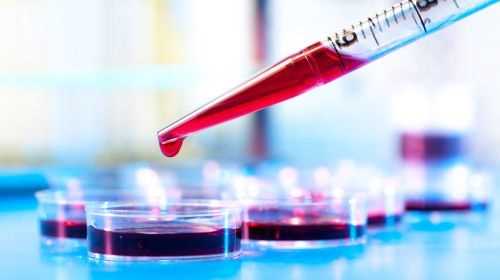If there are too few platelets in the blood, thrombocytopenia is present. The causes of a platelet deficiency are varied, from congenital diseases to medication and vitamin deficiency. What does thrombocytopenia mean and what are the symptoms?
Platelets are formed in the bone marrow and are important for hemostasis: If a blood vessel has been injured, platelets accumulate in the corresponding area as part of blood clotting until the blood vessel is closed again. If too many platelets accumulate by mistake, a blood clot (thrombus) can form and block the blood vessel (thrombosis). If, on the other hand, there are too few platelets in the blood, it is called thrombocytopenia.
Article content at a glance:
What is thrombocytopenia?
Thrombocytopenia is when there are too few platelets in the blood. The limit value is less than 150,000 platelets / µl blood. As a result of thrombocytopenia, hemostasis and blood clotting is disturbed, there is increased bleeding, sometimes even without prior injury. In addition, bleeding takes longer and can be more severe than normal.
Causes of Thrombocytopenia
Thrombocytopenia occurs because either too few platelets are produced in the bone marrow or the platelets have a shortened lifespan and die too quickly. There are different causes for both:
congenital disorders of platelet formation (for example, Wiscott-Aldrich syndrome or Fanconi anemia)
Toxins like alcohol (alcoholism)
Immune thrombocytopenia (Werlhof’s disease, idiopathic thyrombocytopenic purpura, ITP): autoimmune reaction against platelets
Cancers such as leukemia or metastases in the bone marrow
Cirrhosis of the liver and other liver diseases
Medicines such as heparin or antibiotics
Overactive spleen, so that increased blood platelets are broken down
Damage to the bone marrow, which reduces the production of platelets
Pregnancy (gestational thrombocytopenia)
Heavy bleeding leads to a high loss of blood platelets
Thrombotic thrombocytopenic purpura (TTP) or Moschcowitz’s disease
viral infections with the hepatitis C virus, Epstein-Barr virus or HI virus
Vitamin deficiency, especially vitamin B12 and folic acid
Heparin-induced thrombocytopenia
Thrombocytopenia can occur as a complication of treatment with heparin. In type 1 heparin-induced thrombocytopenia, the number of platelets decreases moderately within the first few days after administration of heparin. After a few days, the value normalizes again and treatment with heparin can be continued.
In contrast, type 2 heparin-induced thrombocytopenia leads to an autoimmune reaction: the body produces antibodies which, paradoxically, in turn, produce increased levels of platelets. This increases the risk of thrombosis and circulatory disorders in the arteries and veins. Depending on the severity and the affected blood vessel, type 2 can be life-threatening.
Thrombocytopenia from COVID-19 vaccination
As part of the vaccination against COVID-19 with the vaccine from AstraZeneca, cerebral vein thrombosis together with thrombocytopenia were observed in isolated cases. Cerebral vein thrombosis, also known as sinus vein thrombosis, is a rare form of thrombosis. The few vaccinated people affected were mostly younger than 55 years and showed symptoms of cerebral vein thrombosis and thrombocytopenia four to 16 days after vaccination with AstraZeneca. So far, there is no evidence that the coagulation disorder was caused by the vaccination.
According to the Paul Ehrlich Institute, vaccinated people should see a doctor immediately if they experience shortness of breath, chest pain, leg swelling or abdominal pain after vaccination with AstraZeneca. This also applies to severe headaches, blurred vision and bleeding in the skin (petechiae) that occur outside the puncture site.
Symptoms: how is thrombocytopenia manifested?
Symptoms vary in severity depending on the severity of the thrombocytopenia and the cause. The first sign of thrombocytopenia can be bleeding in the skin and mucous membrane (petechiae). They appear as small red spots, mostly on the legs.
Even if small, harmless injuries lead to severe bruising and bruising, there may be a lack of platelets. Other symptoms include bleeding gums, blood in your urine, or blood in your stool. In women, menstruation can also be unusually heavy. Spontaneous bleeding without external influence is a possible symptom of thrombocytopenia.
In general, injuries that cause bleeding are difficult to stop. Internal bleeding, in the digestive tract or the brain, is particularly problematic. They can be life-threatening if they are not recognized and treated in good time. As a rule, the lower the number of platelets in the blood, the greater the bleeding.
Diagnosis of suspected thrombocytopenia
If there is a suspicion of a platelet deficiency, a blood test is usually carried out in the laboratory. Among other things, the number of platelets and other coagulation parameters such as Quick value, INR and fibrinogen are determined.
Also, if someone has an infection or disease that may cause platelet deficiency, the number of platelets in the blood is routinely checked. Thrombocytopenia is often discovered by chance during a blood test for other reasons if you do not have spontaneous or heavy bleeding or bruising.
Another way to diagnose thrombocytopenia is to examine a sample from the bone marrow. It is primarily used if there is a suspicion of a platelet deficiency due to leukemia or if there is a suspicion of immune thrombocytopenia. In this case, a test for autoantibodies against the enzyme ADAMTS13 is often ordered in order to distinguish thrombotic thrombocytopenic purpura (TTP). In addition to other symptoms, those affected by this rare, serious autoimmune disease suffer from thrombocytopenia.
Treat thrombocytopenia depending on the cause
The platelet deficiency is treated according to the cause and severity. After pregnancy and after an infection has subsided, the number of blood platelets usually returns to normal on its own. If the reason for the thrombocytopenia is taking medication, a new drug is usually prescribed to increase the number of blood platelets again. Drug treatment with immunosuppressants, for example, inhibits the normal metabolism of platelets and should avoid complications due to possible bleeding.
In severe cases of thrombocytopenia, hospitalization is necessary. If the value is below 10,000 / µl blood, those affected receive platelet concentrates by transfusion to compensate for the deficiency. If there is internal bleeding, this will be treated surgically. If the spleen is responsible for the increased breakdown of blood platelets, surgical removal can be carried out. Depending on the extent of the disease and the patient’s condition, leukemia and metastases in the bone marrow are treated with radiation, chemotherapy and allogeneic stem cell transplants.
.


